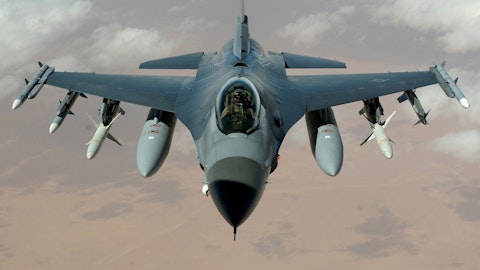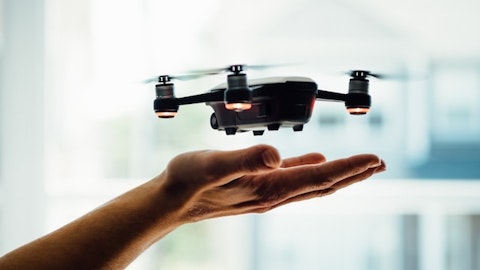Ellen Page: Okay, that’s helpful. I’ll leave it at that.
Rami Myerson: Thanks, Ellen.
Operator: The next question is from Omri Efroni of Oppenheimer. Please go ahead.
Omri Efroni: Hi, guys, and congrats on the very great quarter. Maybe to elaborate on the last question about financial expenses. You have pretty high financial expenses, approximately $140 million for the whole year of ’23. Maybe if you can elaborate a little bit more about the working capital. And how should I think about it? Is it tied up more of one segment? Maybe the average state and land division? And what about the guarantees? Are you thinking about a way to lower the price of credit, of interest and I say on the guarantees and how one should think about it? Thank you.
ButziMachlis: Hi, Omri. So, as discussed previously in our conference, we have $138 million of financial expenses during the year. Part of the expenses are a backlog of more than $4 billion of guarantees, financial guarantees, which we are required to — which we are required to hand to our customers, mainly when we receive down payments. And we are working with the banks, of course, of reducing this cost as much as possible. But we always prefer to issue guarantee, which cost us around half a percent, and receive down payment other than use credit, which cost us at market rates, more than 6%.
Omri Efroni: Okay, great. Thanks for the color. We’re happy if you can give a little bit of explanation about the UAV segment. Now, Elbit is taking its new facility, it’s opening the new facility in Modine. Maybe you can talk about it more of how much capacity is going to be added to the aerospace and especially the tactical UAVs and the large strategic UAVs that you can sell to [indiscernible]. Thanks.
KobiKagan: We received recently many orders for UAVs in many countries, and they are all embedded in the airborne segment. The airborne segment is not just for UAVs, it’s our entire airborne portfolio, which includes the training and simulation, avionics, helmets, and some more activities. But talking specifically on UAVs, we see a growing demand for our UAVs here in Israel, but also around the world. We have, as you know, a family of UAVs, from small tactical UAVs to MALE UAVs. The uniqueness of our solution is not just the UAV itself, it’s our ability to provide operational solution for our customers based on our different sensors and effectors, which are all linked to the UAVs. Actually, what we are able to — our unique offering is not just a simple UAV, is a fully integrated package, which helps several operational scenarios which are required in the market.
And there we bring the entire synergy of the company in order to meet this backlog of UAVs we got recently in many countries, we took a decision to invest in a new facility for UAVs in Modine. And this facility will be inaugurated around the mid — around June, July this year.
Omri Efroni: Great. Maybe a last one for me if I may. And coming to the fourth quarter of ’24, the facility in Ramat Beka is going to come online. How should I think about the ramp-up in the capacity and the production in facility? Is it going to be a quick one or supposedly can be long as six months, three months, 12 months? Thank you.
KobiKagan: We will start production in the new facility in the last quarter. And we will gradually increase capacity and increase production. It will take us probably around nine months to get into full production capacity in that facility and we have invested quite a lot in this new facility. It includes a lot of automation, new robots, new technologies for production. And in order to ensure good quality, improved yields and good productivity for the new program, the level of orders we got recently is requiring this new facility and the investment we made during the last two years will certainly help us to deliver all these goods and all our commitments to our customers.
Omri Efroni: Thank you very much guys. And congrats again.
KobiKagan: Thank you.
Rami Myerson: Thank you, Omri.
ButziMachlis: Thanks Omri.
Operator: The next question is from Atinc Ozkan of WOOD & Company. Please go ahead.
Atinc Ozkan: Thank you, and congratulations for a strong backlog growth at the end of the year. I have three questions today. The first one is if you could provide an update on how we should look at investment needs going forward, given that the Ramat Beka investment will be mostly completed in 2024. I know that you have been spending around $180 million, $200 million per annum, but demand is there and are we going to see new investments from Elbit, let’s say in 2025? My second question is kind of related to that. Given the emerging need for multi-domain warfare across the globe and what we see in Gaza, Red Sea or Ukraine, and given Elbit’s capabilities, wide range of capabilities, in which segment do you see the strongest growth?
Not regions, which segments? For instance, I noticed that there is this emerging kamikaze drones and loitering munition threats and there appears to be no remedies, soft skill or hard skill when these come in swarms. So is there a solution for that? Do you have a specific solution for this that you could basically teach to global militaries? That’s the second one. And the third one is I’ve seen some articles in Israeli press that the MoU with Itochu in Japan has been cancelled. But Japan is probably going to be the third largest military defender. They are boosting — spender — they are boosting their defense budget. So what is your strategy there to basically penetrate this important market? Thank you.




